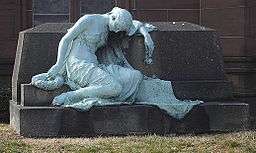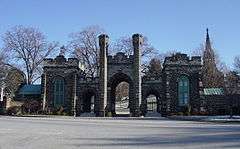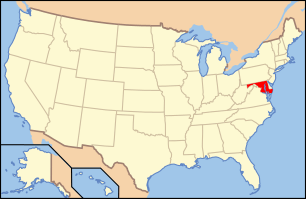Green Mount Cemetery
Coordinates: 39°18′27″N 76°36′26″W / 39.30750°N 76.60722°W
|
Green Mount Cemetery | |
|
The Main Gate at the Green Mount Cemetery. | |
   | |
| Location |
1501 Greenmount Avenue Baltimore, Maryland 21202 |
|---|---|
| Built | 1839 |
| Architect | Robert Cary Long, Jr., et al. |
| Architectural style | Mixed (multiple styles from different periods), Gothic Revival |
| NRHP Reference # | 80001786[1] |
| Added to NRHP | April 2, 1980 |
Green Mount Cemetery is a historic cemetery in Baltimore, Maryland, United States. Established on March 15, 1838, and dedicated on July 13, 1839, it is noted for the large number of historical figures interred in its grounds as well as a large number of prominent Baltimore-area families. It retained the name Green Mount when the land was purchased from the heirs of Baltimore merchant Robert Oliver. Green Mount is a treasury of precious works of art, including striking works by major sculptors including William H. Rinehart and Hans Schuler.
The cemetery was listed in the National Register of Historic Places in 1980. Guided tours are available at various times of the year.
A Baltimore City Landmark plaque at the entrance reads:
- "Green Mount Cemetery was dedicated in 1839 on the site of the former country estate of Robert Oliver. This was at the beginning of the 'rural cemetery movement'; Green Mount was Baltimore's first such rural cemetery and one of the first in the U.S. The movement began both as a response to the health hazard posed by overcrowded church graveyards, and as part of the larger Romantic movement of the mid-1800s, which glorified nature and appealed to emotions.
- Green Mount reflects the romanticism of its age, not only by its very existence, but also by its buildings and sculpture. The gateway, designed by Robert Cary Long, Jr., and the hilltop chapel, designed by J. Rudolph Niernsee and J. Crawford Neilson, are Gothic Revival, a romantic style recalling medieval buildings remote in time.
- Nearly 65,000 people are buried here, including the poet Sydney Lanier, philanthropists Johns Hopkins and Enoch Pratt, Napoleon Bonaparte's sister-in-law Betsy Patterson, John Wilkes Booth, and numerous military, political and business leaders."
In addition to John Wilkes Booth, two other conspirators in the assassination of Abraham Lincoln are buried here, Samuel Arnold and Michael O'Laughlen. It is common for visitors to the cemetery to leave pennies on the graves of the three men; the one-cent coin features the likeness of the president they successfully sought to murder.[2]
Until a 1965 agreement with Queen Elizabeth II, the Duke and Duchess of Windsor had planned for a burial in a purchased plot in Rose Circle at Green Mount Cemetery, near where the father of the Duchess was interred. The 1965 agreement allowed for the former King Edward VIII and wife, the Duchess of Windsor, to be buried near other members of the royal family in the Royal Burial Ground near Windsor Castle.[3]
Notable interments



- Arunah Abell (1808–1888), journalist, newspaper publisher, founder of the Philadelphia Public Ledger and Baltimore Sun newspapers.
- William Julian Albert (1816–1879), U.S. Congressman.
- Samuel Arnold (1834–1906), Lincoln assassination conspirator.
- James Monroe Bankhead (1783–1856), U. S. Army General that served in the War of 1812, Second Seminole War, and Mexican–American War.
- Daniel Moreau Barringer (1806–1873), a United States Congressman and diplomat.
- A. Aubrey Bodine (1906–1970), photographer
- Elizabeth ("Betsy") Patterson Bonaparte (1785–1879), Baltimore-born wife of Napoleon's brother, Jérôme Bonaparte (m. 1803). Napoleon refused to recognize the marriage. When Jérôme returned to France in 1805, his wife was forbidden to debark and went to England, where her son, Jérôme Napoléon Bonaparte, was born. Napoleon issued a state decree of annulment for his brother in 1806, and Elizabeth Patterson returned to Baltimore with her son.
- Elijah Bond, (1847–1921), lawyer and inventor.
- Asia Frigga (Booth) Clarke, (1835–1888), author and sister of John Wilkes Booth.
- John Wilkes Booth (1838–1865), assassin of President Abraham Lincoln.
- Junius Brutus Booth (1796–1852), noted English actor, the foremost tragedian of the early-to-mid 19th century.
- Mary Ann Holmes Booth (1802–1885), wife of Junius Brutus Booth and mother of John Wilkes Booth.
- Augustus Bradford (1806–1881), Governor of Maryland.
- Jesse D. Bright (1812–1875), United States Senator from Indiana.
- Frank Brown (1846–1920), Governor of Maryland.
- James M. Buchanan (1803–1876), Judge and United States Ambassador to Denmark.
- James Buck (1808–1865), an American Civil War Medal of Honor recipient.
- John Archibald Campbell (1811–1889), was a United States Supreme Court Justice.
- Henry Winter Davis (1817–1865), U.S. Congressman for Maryland's 3rd District, 1863–1865.
- Allen Welsh Dulles (1893–1969), director of the Central Intelligence Agency and a member of the Warren Commission.
- Wendell E. Dunn (1894–1965), educator and principal of Forest Park High School
- Wendell E. Dunn, Jr. (1922–2007), metallurgist and chemical engineer
- Thomas Dunn (1925–2008), musician and conductor
- Johnny Eck (1911–1991), American freak show performer born without legs.
- Arnold Elzey (1816–1871), Confederate Civil War general from Maryland.
- George F. Emmons (1811–1884), Rear Admiral, United States Navy.
- George Hyde Fallon (1902–1980), U.S. Congressman, 4th District of Maryland
- Robert G. Harper (1765–1825), United States Senator from Maryland.
- Johns Hopkins (1795–1873), businessman and philanthropist. He left substantial bequests in his will to found the Johns Hopkins University and Johns Hopkins Hospital.
- Benjamin Chew Howard (1791–1872), a congressman and the fifth reporter of decisions of the United States Supreme Court
- Benjamin Huger (1805–1877), a career United States Army ordnance officer and a Confederate general in the American Civil War.
- Reverdy Johnson (1796–1876), statesman, United States Senator and United States Attorney General.
- Joseph Eggleston Johnston (1807–1891), military officer in the Confederate States Army during the American Civil War.
- Isaac Dashiell Jones (1806–1893), U.S. Congressman
- Anthony Kennedy (1810–1892), United States Senator.
- John P. Kennedy (1795–1870), congressman and United States Secretary of the Navy.
- Harriet Lane (1830–1903), niece of President James Buchanan, acted as First Lady of the United States from 1857 to 1861.
- Sidney Lanier (1842–1881), musician and poet.
- Walter Lord (1917–2002), author, best known for his novel A Night to Remember.
- John Gresham Machen (1881–1937), influential Presbyterian theologian and founder of Westminster Theological Seminary in Philadelphia, Pennsylvania
- John MacTavish (1787–1852), British Consul to Maryland in the 1840s
- Charles Marshall (1830–1902), colonel in the Confederate States Army, aide de camp, assistant adjutant general, and military secretary for the Army of Northern Virginia and Gen. Robert E. Lee.
- Theodore R. McKeldin (1900–1974), Mayor of Baltimore and Governor of Maryland.
- Louis McLane (1786–1857), United States Congressman from Delaware, United States Secretary of the Treasury, and later the United States Secretary of State.
- Robert Milligan McLane (1815–1898), Governor of Maryland.
- Louis Wardlaw Miles (1873–1944), World War I Medal of Honor Recipient.
- John Nelson (1794–1860), United States Attorney General.
- Harry W. Nice (1877–1941), Governor of Maryland.
- Daniel S. Norton (1829–1870), US Senator
- Columbus O'Donnell (1792–1873), founder of the Canton Company.
- Michael O'Laughlen (1840–1867), Lincoln assassination conspirator.
- Edward Coote Pinkney (1802–1828), poet.
- John P. Poe, Sr. (1836–1909), Attorney General of Maryland, 1891–1895.
- William Rinehart (1825–1874), sculptor.
- Cadwalader Ringgold (1802–1867), U.S. Navy officer
- Albert C. Ritchie (1876–1936), Governor of Maryland, 1920–1935.
- Major General George H. Steuart (1790–1867), a United States Army general in the War of 1812.
- George H. Steuart (1828–1903), a Confederate general in the American Civil War.
- Thomas Swann (1809–1883), Governor of Maryland, 1866–1869, U.S. Congressman for Maryland's 3rd and 4th Districts, 1869–1879, Mayor of Baltimore, 1856–1860.
- Isaac R. Trimble (1802–1888), a U.S. Army officer, civil engineer, a prominent railroad construction superintendent and executive, and a Confederate general in the American Civil War.
- Daniel Turner (1794–1850), United States Navy officer during the War of 1812.
- Erastus B. Tyler (1822–1891), Union Army general in the American Civil War.
- Henry Walters (1848–1931), president of the Atlantic Coast Line Railroad, art collector whose bequest to the City of Baltimore in 1931 started the Walters Art Museum
- William Thompson Walters (1820–1894), Liquor distributor, banker, railroad magnate and art collector.
- Teackle Wallis Warfield (1869–1896), father of the Duchess of Windsor.
- John Watchman Founder of Watchman Fire Co #16 of Baltimore (c. 1840), partner of Watchman & Bratt Steam Engine Mfgs., Baltimore.
- William Pinkney Whyte (1824–1908), Maryland State Delegate, State Comptroller, a United States Senator, the State Governor, the Mayor of Baltimore, and State Attorney General.
- Joseph Pere Bell Wilmer (1812–1878), Episcopal bishop of Louisiana
- John H. Winder (1800–1865), Confederate general during the American Civil War
- James W. Heitz (1932-2016), prominent businessman, founder of Baltimore Travel Center
References
| Wikimedia Commons has media related to Green Mount Cemetery. |
- ↑ National Park Service (2007-01-23). "National Register Information System". National Register of Historic Places. National Park Service.
- ↑ Kim A. O’Connell (March 2009). The Battle Is Over. America's Civil War Magazine. pp. 59–61.
- ↑ Rasmussen, Frederick (April 29, 1986), Windsors had a plot at Green Mount, Baltimore MD: The Baltimore Sun
External links
- Official Green Mount Cemetery website
- Green Mount Cemetery at Find A Grave
- Green Mount Cemetery Famous People Map Grave Marker Locations
- Pictures and other information at EastGhost
- Green Mount Cemetery at Cold Marble
- Photos of Green Mount Cemetery on Flickr
- Green Mount Cemetery at the Political Graveyard
- Green Mount Cemetery on Explore Baltimore Heritage


